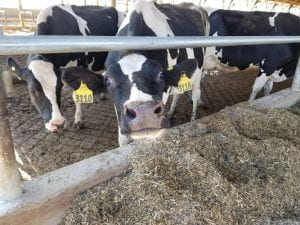Feeding dairy cows in the summertime comes with its own unique set of challenges. These challenges can manifest as variable dry matter intakes, sorting, butterfat issues or metabolic issues, and more. While most of these things should be considered as symptoms, getting down to the issue at hand is critical to preventing these challenges from becoming a serious problem.
Troubleshooting On Farm
If summer is usually a more challenging time for your herd, there are a few places to troubleshoot for problems, including ration consistency, TMR heating and cattle behavior.
Starting at the feed bunk, feed should be assessed at delivery for consistency and heating. These same two things should be assessed at different timepoints during the day, and then again before it’s removed as refusals. The goal of refusals should be that it very closely resembles the consistency of the feed as it was delivered. A TMR audit (please include this link in “TMR AUDIT”: https://www.progressivedairy.com/topics/feed-nutrition/how-to-audit-your-tmr-ration-for-consistency) can be performed along the length of bunk that a load of feed was delivered to give more information about the consistency of delivery. Refusals can be submitted for nutrient analysis alongside fresh TMR to ensure minimal nutrient changes.
Temperature changes can be assessed using composting thermometers. For heating issues, finding the source of the heating is crucial for minimizing its impact. Most nutritional consultants have access to thermo-imaging cameras, which can be used to assess bunk face temperature. Approaching a bunk face with a composting thermometer to assess temperature is discouraged because of safety issues and should be avoided. If no thermo-imaging camera is available, a section of bunk can be defaced and bucketed away using a loader to assess for temperature using a thermometer safely away from the face.
Cattle should be observed for signs of sorting, preferring feed at one particular end of the bunk over another, or any other behavioral indicators that could clue into a potential issue. CCE, as well as many consultants, have time-lapse cameras to put up in barns to watch for patterns.
Strategies to Help
If any of these areas (TMR consistency, feed temperature, sorting) shows a deviation from what is desired, the herd is likely experiencing some issues, even if they haven’t become a major problem yet. The TMR audit link above walks through some keys for digging into TMR audit results. Monitoring cattle behavior after a change is made, as well as performing a follow-up TMR audit can be helpful to assess differences.
If feed temperature is an issue, there are several ways to minimize any downstream effects from a heating issue.
- Audit bunk management practices – is enough being removed from the face every day? Is a tight face being maintained? Is only enough feed for that day being removed?
- Binders can be included in the diet to minimize toxin issues from molds or yeast, although these sometimes have limited effectiveness in tough forage situations. 2021 corn silage crop has been challenging for some farmers. Has that crop been tested for mycotoxin levels? Have they changed?
- Antioxidant feed additives can help maintain feed freshness and keep feed cool – again, farmers have seen mixed results with these additives so be sure it can work in your particular situation.
- Limiting or replacing the problematic forage in high priority groups (prefresh, fresh and high groups) is encouraged if neither of the first two options is desired.
- Feeding more than once a day can be considered, although weighing load sizes versus number of loads should be a consideration, especially in smaller loads (load consistency issues) and with the high price of fuel (mixing cost)
- Consider discarding refusals completely, or at least not feeding to lactating groups or high priority groups. Many farms only feed refusals to pregnant heifers or a beef group and have stopped feeding refusals to lactating groups altogether.
- Audit feed bunk management. Are refusals completely removed daily? Early in my nutrition career, there was a farm with a rough, pitted feed bunk that wound up not being able to be cleaned up thoroughly. Feeds stuck in these areas, and left heating, undesirable feed that was causing butterfat issues. Attention to cleaning this area helped dry matter intake and helped correct butterfat.
Thoughts on Targeting Feed Refusal Amounts
A good article I came across from PennState Extension (https://extension.psu.edu/what-is-your-feed-refusal-costing-you ) covers some good food for thought on targeting refusals for groups. Especially in times of high feed prices, it makes sense to go over feed refusal amounts and target appropriately according to group being fed. As shared in the article, “It is often recommended that refusals for the fresh group remain around 2 to 4%, 1 to 3% for high groups, and 0.5 to 3% for late-lactation groups. In general, feed refusal should not exceed 3 to 4%. A point to note is that if feed refusals are similar in composition to feed offered, you can go for the low end numbers. If the feed refused is different from what is offered, you should go for the high end numbers.”
Monitoring Results
As is always said, “you can’t measure what you don’t monitor”. Be sure to write down and date the herd’s “before” numbers, the date of the change and what was changed to adequately compare to the herd’s “after” numbers. Whether these are herd metabolic statistics, butterfat results, dry matter intake or feed delivery variation, knowing where numbers started, what the goal is and when a specific change was made are keys to deciding if a change was effective.

